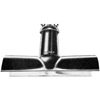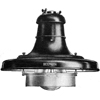|
|
duoflux
Described as a new type of floodlight for downward and forward illumination in 1932. It prevented loss
of light in an upward direction and the cut-off reflector also eliminated glare.
|
|
Duoflux
|
??? GLS
|
GES
|
Post Top
|
No Gear
|
1932 Catalogue
1939 Journal
|
|
|

|
rodalux
The feature of the Rodalux unit is the longitudinal effect obtained from the cylindrical
form of reflector, which has been designed in several forms to meet the requirements of
different methods of spacing.
This was a fitting for the lighting of long narrow areas at wide spacing. It was installed
in streets, wharfs, docks, railway good yards and tunnels..
|
|
Rodalux
|
500-750W GLS
|
GES
|
???
|
No Gear
|
1928 Journal
1932 Catalogue
|
|
|
|
|
durban lantern
This lanterns had a symmetrical distribution which maintained the illumination values for wide spacing
ratios of the order of 5:1 and 10:1. The light control was by means of a simple reflector, which also gave
a definite cut-off and thus provided more comfortable vision.
|
|
Durban
|
??? GLS
|
GES
|
???
|
No Gear
|
1932 Catalogue
|
|
|
|
|
danger lamp
This lantern was designed for suspension over dangerous cross roads where it floodlit point
policemen. The large vitreous enamlled reflector gave a soft intense downward flood whilst the
ruby glass panels in the skirt gave early visual warning to approaching traffic.
|
|
Danger
|
??? GLS
|
GES
|
???
|
No Gear
|
1932 Catalogue
|
|
|

|
biflector
This achieves an exceptionally "extensive" curve of light distribution with a minimum of glare
owing to the user of a diffusing metal rim under the reflector.
This lantern was primarily a wide spacing industrial reflector but also found use in street
lighting where the deep skirt ensured comfortable vision.
|
|
Biflector
|
??? GLS
|
GES
|
???
|
No Gear
|
1928 Journal
1932 Catalogue
|
|
|
|
|
horolux
Having no skirt, this reflector was recommended for use with pearl or opal lamps for street lighting
in rural districts. It was also recommended for positions where a distribution of light above
the horizontal was needed e.g. Goods Yards, Wharfs, Docks, etc.
|
|
Horolux
|
??? GLS
|
GES
|
???
|
No Gear
|
1932 Catalogue
|
|
|
|
|
biflector lantern
Combined a decorative effect with a high effeciency. For lighting Promenades, Boulevards and entrances to public buildings.
|
|
Biflector Lantern
|
??? GLS
|
GES
|
???
|
No Gear
|
1932 Catalogue
|
|
|
|
|
porcelain wellglass fittings
Being proof against corrosive vapours, these lanterns were particularly suitable for Public Lavatories, etc., and
also for situations where it was essential to protect the lampholders and other electrical parts.
|
|
Porcelain Wellglass Fittings
|
??? GLS
|
GES
|
???
|
No Gear
|
1932 Catalogue
|
|
|
|
|
invercone
This was a popular inverted cone type of reflector for lighting subsidiary roads where a low initial cost and
high efficiency were required.
|
|
Invercone
|
??? GLS
|
GES
|
???
|
No Gear
|
1932 Catalogue
|
|
|
|
|
elliptical angle
This was used for the lighting of Public Tennis Courts, etc. from the sides and also for
all types of sign lighting, etc.
|
|
Elliptical Angle
|
??? GLS
|
GES
|
???
|
No Gear
|
1932 Catalogue
|
|
|
|
|
bencolite design "k"
This was a totally enclosed diffusing fitting with bronze chain suspension for offices, or alternatively with
a tube suspension finished white enamel for hospitals, etc.
|
|
Bencolite Design "K"
|
??? GLS
|
GES
|
???
|
No Gear
|
1932 Catalogue
|
|
|
|
|
bencolite design "x"
This was similar to the above but provided a choice of standard glassware.
|
|
Bencolite Design "X"
|
??? GLS
|
GES
|
???
|
No Gear
|
1932 Catalogue
|
|
|
|
|
intensolux
This was for high intensity lighting of small areas, spot lighting Point Policemen etc., maintenance being simplified
by the special dust tight cover glass.
|
|
Intensolux
|
??? GLS
|
GES
|
???
|
No Gear
|
1932 Catalogue
|
|
|
|
|
projectolux
This was a handy sized, totally enclosed, floodlight for public buildings of medium height, where the available
proection was limited. It was also applicable for lighting high signs.
|
|
Projectolux
|
??? GLS
|
GES
|
???
|
No Gear
|
1932 Catalogue
|
|
|
|
|
shadowlites
These were designed for lighting public halls and offices where a decorative effect combined with efficient diffusion
was required. Pratically shadowless quality of light was obtained by a fully patented principle. (This suggest an indirect lighting lantern).
|
|
Shadowlites
|
??? GLS
|
GES
|
???
|
No Gear
|
1932 Catalogue
|
|
|
|
|
r.l.m.
This was the standard of the B.E.S.A. Industrial Dispersive Reflector for all types of industrial installations. It also
had many other commercial applications in which is has proved very successful.
|
|
R.L.M
|
??? GLS
|
GES
|
???
|
No Gear
|
1932 Catalogue
|
|
|
|
|
glassteel diffusers
This unit combined the efficiency of the R.L.M. with the high light quality of the diffusing globe. It was ideal for
use in areas where close eye work was carried out, e.g., in offices, schools, reading rooms, etc.
|
|
Glassteel Diffusers
|
??? GLS
|
GES
|
???
|
No Gear
|
1932 Catalogue
|
|
|
|
|
elliptical vertical
This provided a distribution long in relation to its width. It was used for lighting Library book stacks, gangways, etc.
|
|
Elliptical Vertical
|
??? GLS
|
GES
|
???
|
No Gear
|
1932 Catalogue
|
|
|



